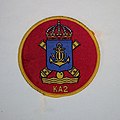Colours, standards and guidons
The regimental colour was presented to the former Royal Karlskrona Coastal Artillery Regiment (KA 2) at the Stockholm Palace in Stockholm by His Majesty the King Gustaf V on 1 June 1945. It was used as regimental colour by KA 2 until 1 July 2001. [7] The regimental commander, Colonel Alf Nyman, received the colour from the hands of the king. [8] In connection with the disbandment ceremony on 31 October 2000, the colour was handed over to the South Coast Naval Base, which is the unit that will carry forward the traditions of the Karlskrona Coastal Artillery Regiment. [8]
The regimental colour was drawn by Brita Grep and embroidered by hand in insertion technique by the company Libraria. Blazon: "On red cloth in the centre the badge of the former Coastal Artillery; two gunbarrels of older pattern in saltire between a royal crown proper and a blazing grenade and waves, all in yellow. In the first corner the monogram of HM King Carl XI surmounting an erect anchor under a royal crown proper, all in yellow". [7]
Marches
"Kongl Carlskrona artillerikårs marsch" was written in 1895 by Frans Ferdinand Heimdahl (1848–1929) and was adopted the same year. Heimdahl was music director in Karlskrona Artillery Corps from 1895 to 1901, at the Royal Swedish Navy Band in Karlskrona from 1874 to 1914 and in Halland Battalion from 1897 to 1901. When Karlskrona Coastal Artillery Regiment was raised in 1902, the march became the regimental march and remained so until 31 March 1910. In 1992, the march was adopted as a march for the Karlskrona Marine Group (Karlskrona maringrupp) and as such was maintained until the unit's disbandment in 1996. In 2001, the march was again adopted as a unit march, now for the Blekinge Archipelago Home Guard Battalion (Blekinge skärgårdshemvärnsbataljon). [10]
"Kungl Karlskrona kustartilleriregementes marsch" was written in 1910 by the music director at KA 2, August Sjögren (1862–1929). The march was dedicated to the then regimental commander Carl Gustaf Ahlborn, and was adopted as a unit march on 1 April 1910. The march came to remain the regimental march until the disbandment on 31 October 2000. Sjögren served as music director in the regiment from 1905 to 1918. [10]
"KA 2 marschvisa" was added in 1942. The music was composed by Sven-Gösta Elmqvist, reserve officer of the regiment and the text was written by the then lieutenant of the regiment Sven Olof (Ola) Träff, later self-employed and member of the Riksdag. [10]
"Överste Gösta Möller" was written in 1943 by the music director of the regiment Bertil Driwing (1912–1991). The march was dedicated to the outgoing regimental commander Gösta Möller and received the subtitle "Ett lag eld", a regular fire command of the coastal artillery units. [10]
"KA 2-kamrater" was written for KA 2 Kamratförening's 50th anniversary by Kjell Rosell (Larsson) (born 1912) and was handed over on the anniversary day 14 June to the then regimental commander and chairman of the Kamratförening, Colonel Roland Hultgren. Kjell Rosell was a musician in KA 2 from 1929 to 1935. His instruments were cornet and trumpet. [10]
"KA 2 jubileumsmarsch" was written for KA 2's 90th anniversary in June 1992 by Eskil Nyström (born 1923). The march was dedicated to the then regimental commander Colonel Bengt-Arne Johansson. Eskil Nyström was a musician in KA 2 from 1943 until the disbandment of the music corps in 1957, when he was transferred to the Royal Swedish Navy Band in Karlskrona. His instruments were clarinet and saxophone. In the march there are loops of both "KA 2 marsch" and "KA 2 marschvisa". [11]
"3. amfibiebataljonens marsch" is also a work by Eskil Nyström. This march was added in 1997, which was the first year when the entire amphibious system was trained in KA 2. The march was dedicated to the then amphibious battalion commander Günter Villman. [11]
"Överste Villman" is also a work by Eskil Nyström and was originally written as an anniversary march for the regiment's 100th anniversary. When the decision to disband the regiment came, the march was renamed to "Överste Villman" and was dedicated to KA 2's last regimental commander, Colonel Günter Villman. In the march, "KA 2 igenkänningssignal" is heard, a few beats of the march song and a few beats of the "Blekingesången", the latter to mark the regiment as a real native regiment. [11]
"KA 2 igenkänningssignal". The recognition signal is intended for clarion (B instrument). [11]












